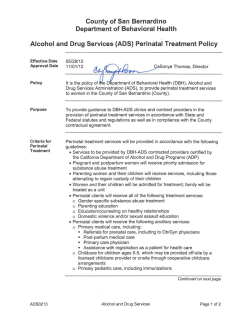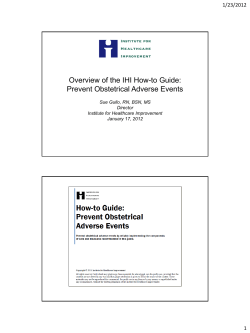
Kacie W`s presentation April 7
Prenatal, perinatal, and neonatal risk factors for specific language impairment: A prospec8ve cohort study (Whitehouse, Shelton, Ing, & Newnham, 2014) KACIE WITTKE NEURODEVELOPMENT 4/7/15 Mo8va8on SLI is one of the most common neurodevelopmental disorders Long-‐term consequences to language impairment Gene:c basis to language impairment v But what are the pre-‐ and postnatal environmental factors involved in the expression of SLI? Previous research has been conducted retrospec:vely, mostly null findings v Prospec:ve longitudinal study reduces demands on parent recall Par8cipants Western Australia Pregnancy Cohort (Raine Study): prospec:ve cohort inves:ga:on of pregnant women and their offspring v Final sample of 2,979 pregnancies (2,868 live-‐born children) Inclusionary criteria for SLI-‐C and Comparison groups: v SLI-‐C: combina:on of SLI-‐E + SLI-‐M (n = 26 children) ü SLI-‐E: children assigned to SLI with expressive deficits (n = 12) ü SLI-‐M: children with mixed recep:ve and expressive disorder (n = 14) v Comparison group: no significant developmental delays (n = 1,799 children) Assessments Infant Monitoring Ques:onnaire (completed between at 12, 24, and 36 months) Peabody-‐Picture Vocabulary Test-‐Revised (PPVT-‐R; completed at 5 and 10 years) Clinical Evalua:on of Language Fundamentals, Third Edi:on (CELF-‐3; completed at 10 years) Raven’s Colored Progressive Matrices (RCPM; completed at 10 years) Data on Risk Factors Prenatal (from concep/on prior to onset of labor) v Mothers completed study ques:onnaires during the 18th and 34th weeks of pregnancy v Researchers reviewed mother’s medical record for exis:ng and pregnancy-‐induced health complaints, complica:ons, and admiaance to hospital. Perinatal (onset of labor to delivery of child) v Labor characteris:cs were obtained from medical record (labor onset, fetal presenta:on on admiaance to hospital, maternal fever, administra:on of medica:ons during labor, dura:on of labor, atypical placental or umbilical cord shape, mode of delivery, birth order, and season of birth) v Appropriateness of fetal growth, propor:on of op:mal birth weight (to classify IUGR) Neonatal (end of delivery to discharge from hospital) v Fetal health (:me to spontaneous respira:on, requirement of resuscita:on, evidence of birth trauma, Apgar scores, admiaance to intensive care) v First few days of life (any complica:on such as poor sucking/feeding, hypoglycemia, jaundice, anemia, and difficulty maintaining temperature) Results: Socio-‐demographic Factors Results: Language and Cogni7ve Abili7es Results: Prenatal, Perinatal, and Neonatal Characteris7cs Discussion No between-‐group differences on the majority of factors considered, including range of obstetric complica:on and labor/delivery characteris:cs. Null findings replicate the other three exis:ng studies in this area, sugges:ng that the vast majority of prenatal, perinatal, and neonatal factors do not play a clear causal role in SLI. v Tomblin et al. (1997): obtained obstetric history of children with SLI via phone interview, and found no group differences with TD peers in maternal exposure to disease and other teratogens during pregnancy, as well as a range of perinatal characteris:cs such as labor and mode of delivery v Bishop (1997): compared obstetric records between a clinical group (84 twin pairs where one or both twins had SLI) with a control group (36 twin pairs with no history of speech-‐language difficul:es), and pre-‐eclampsia was the only factor more common in children with SLI v Merricks et al. (2004): no associa:on between SLI and a range of obstetric complica:ons Possibili*es: 1. More subtle environmental effects are involved in e:ology of SLI. 2. Effects of early life events on neurodevelopmental disorder are small and can be observed only when calcula:ng aggregate risk scores. Limita8ons Iden:fica:on and characteriza:on of SLI group Grouping SLI-‐E and SLI-‐M may have been too phenotypically heterogeneous. Sample aari:on: 20% of original sample, and more common among children whose mothers did not complete secondary school educa:on. Prevalence of SLI in current sample was 1.42%. References Bishop, D. V. M. (1997). Pre-‐ and perinatal hazards and family background in children with specific language impairments: A study of twins. Brain and Language, 56, 1-‐26. Merricks, M., Stoa, C., Goodyer, I., & Bolton, P. (2004). The ae:ology of specific language impairment: No evidence of a role for obstetric complica:ons. Journal of Neural Transmission, 111, 773-‐789. Tomblin, J. B., Smith, E., & Zhang, X. Y. (1997). Epidemiology of specific language impairment: Prenatal and perinatal risk factors. Journal of Communica*on Disorders, 30, 325-‐344. Whitehouse, A. J. O., Shelton, W. M. R., Ing, C., & Newnham, J. P. (2014). Prenatal, perinatal, and neonatal risk factors for specific language impairment: A prospec:ve pregnancy cohort study. Journal of Speech, Language, and Hearing Research, 57, 1418-‐1427.
© Copyright 2025










